Last updated: November 10, 2025
4,429 words, 23 minutes read time.

Properly developing dough will give you a fighting chance at baking a lot of great sourdough bread. A better stand mixer is an essential tool for the aspiring bread baker. I bake sourdough bread for extended family, friends, and neighbors, and they want more. Now, what makes for a good stand mixer?
A respectable array of stand mixers is available for mixing flour, water, and salt, not only for kneading but also for developing dough. KitchenAid mixers are well-known, of course. But, with the exception perhaps of the commercial KitchenAid 8 Quart Bowl Lift Stand Mixer, most consumer-oriented KitchenAids are arguably too lightweight for heavy-duty kneading of intermediate volumes of bread dough.
So, am I in the market for a new mixer to replace my Bosch? Not yet. However, I wouldn’t mind testing out a prosumer model.
To help myself and others looking, I compiled this list of mixers capable of handling as little as 4 lbs and up to 18 lbs of dough.
NutriMill Artiste
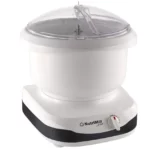
September 2023
I got the Nutrimill Artiste bottom-drive stand mixer on sale in Fall 2023 for $200. It is regularly sold for $299. The lid had a sticker stating a maximum dough capacity of 6 lbs or 2.7 kg (2,700 g), more than enough for two large or three to four smaller loaves. This mixer provided an excellent starting point for me in bread baking.
However, the user manual states a maximum load for bread dough of 8 lbs, which is 3.6 kg. I typically work with dough weighing up to 3.4 kg, which maximizes the 6.5-quart capacity of the mixing bowl as the dough rises high on the center column.
I was unsure how the Artiste, with its screwed-in center column, would handle a stiffer, low-hydration dough typical for soft German pretzels. I tried making pretzels in December 2023, and the mixer kneaded the 1.4 kg (1,400 g) dough for 12 pretzels into a cohesive ball very nicely. However, mixing a much larger batch of stiff pretzel dough might be too taxing for the Artiste.
NutriMill sells a high-capacity, bottom-drive stainless steel bowl (a design without a tall center column) that can replace the Artiste’s 6.5-quart plastic bowl. However, NutriMill advised me that despite the larger capacity of the bottom-drive stainless steel bowl, the machinery inside the Artiste itself should not be taxed with more than 6 lbs or 2.7 kg of dough.
The Artiste works very well for most home bakers, but is not suitable for a sourdough baker like me trying to crank out higher volumes of bread. I fear maxing out that capable little mixer.
December 2024
NutriMill had its annual Christmas sale, and I could not resist upgrading to the White Bosch Universal Plus. The Universal Plus comes with a white plastic bowl and is branded as being built with a stronger motor than the Artiste. Yes, the Bosch feels more powerful – whatever that means.
Bosch Universal Plus
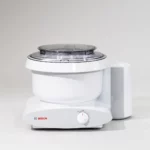
NutriMill sells the Bosch Universal Plus, a stand mixer with a more robust motor than the Artiste. With its numerous attachments, the Bosch is, in my opinion, an ideal mixer for most home bakers, including those who regularly mix bread dough for a few loaves.
There are two versions of the Bosch Universal Plus mixer sold by NutriMill. The White and the Black mixer. What’s the difference? The white version has a 6.5 qt bowl made from sturdy plastic, while the Black version has a 6.5 qt stainless-steel bowl with a screwed-in plastic column. Both bowls have a plastic center column, but the white bowl’s center column is seamlessly molded as an integral part of the bowl, rather than a screw-in component.
I know, it isn’t very clear. But here’s the thing: as of Summer 2025, NurtiMill’s website and Facebook ads state that the White mixer with the sturdy plastic bowl can mix dough up to 14 x 1lb loaves (~6.35kg), while the Black mixer with the stainless-steel bowl can only handle dough up to 10 x 1lb loaves (~4.54kg). I asked NutriMill why that is, and support at L’Chef, the parent company of NutriMill, answered that the stainless-steel bowl’s center column can come loose as it is screwed in. Same as in the Artiste, I guess. That is, the entire bowl of the Black mixer is composed of two pieces: a metal outer bowl and a screw-in plastic center column.
I infer that the homogenous molding of the white bowl is therefore superior in strength to the stainless-steel bowl.
Some people might prefer stainless steel for its aesthetic appeal, while others are biased against plastic due to health concerns, and yet others might mix a batter with ingredients that are too hot for even sturdy plastic. I get all that. However, I bake a lot of loaves and pretzels and thus prefer a sturdy, large-capacity plastic bowl.
NutriMill’s website and Facebook ads claim that the Bosch Universal Plus can knead up to 14 pounds of dough. Did I get that wrong? Well, true as 14 pounds might be in the abstract, a baker will have a hard time properly developing that much dough in the Bosch mixer – at least with high-hydration dough for sourdough bread. Mixing – yes, kneading – perhaps, but developing to a proper gluten structure?
Bagel dough might contain a ratio of 65% water to 100% flour. My high-hydration dough sits at a ratio of 80% water to flour. That wet mass of dough requires a lot of kneading and a few stretch-and-folds.
Developing high-hydration dough starts with mixing and kneading. It implies that the dough is kneaded properly so that when it leaves the mixing bowl, it is capable of trapping gas and maintaining its shape as a consistent mass, all without the need for numerous subsequent stretch and folds.
For as much as 14 pounds of flour, water, and salt to make it to that illustrious outcome of a well-developed dough, a spiral mixer is the better tool. And that is the secret not being disclosed by the commercial advocates of multi-purpose mixers.
The versatile Bosch Universal Plus with the white plastic bowl will work very well for most home bakers, but it is less suitable for a sourdough baker like me who wishes to produce higher volumes of bread. I really should get a prosumer mixer.
Let me share my experience in more detail.
14 x 1 pound loaves?
January 2025
Well, after trying the Bosch Universal Plus with the white bowl, I have conflicting feelings about my use of the Artiste and the Bosch. Both are capable stand mixers, with the Bosch being more versatile. I now own both of them. However, my situation is that I am baking bread not only for my family but also for friends and neighbors. I typically need to mix up to 7 kg (15 lbs) of high-hydration dough for 8 to 10 loaves of bread. This effort entails not just mixing but heavy-duty kneading of high-hydration dough.
Here is a gripe about the Bosch Universal’s bowl, center column, and drive shaft. Whenever I prepare and mix 3.4 kg of high-hydration dough in the Bosch, the wet dough rises on the center column and above, also covering the top of the dough hook. The same applies to the Artiste, and by itself, this is not a significant issue. However, with the Bosch, some dough then slips underneath the dough hook and into the center column and down along the inner drive shaft. This annoys me, to put it mildly. High-hydration dough is relatively wet and will exploit any little crevice. So much for the German engineering of the Bosch mixer.
Now, out of a sense of fairness, I admit my bias as a baker trying to build out a micro bakery. I am simply not a regular user for the Bosch, and that is not the Bosch’s fault. I am pleased to one day pass on the Bosch to my daughter, who has just started a family. She won’t be maxing out the mixer anytime soon. However, ads promoting a Bosch Universal’s capability of handling dough for 14 x 1 lb loaves (~6.35kg) can be a bit misleading.

The Artiste’s bowl, center column, hook, and drive shaft assembly sports a more elaborate design solution to prevent the dough from seeping through the crevices and into the assembly. Yes, the center column in the Artiste’s bowl is screwed in, which is a potential point of breakage when mixing a lot of stiff dough. However, the Artiste’s drive shaft features two hard-plastic washers and a soft-plastic seal to provide for a snug fit within the screwed-in center column during operations. I never had much of my dough getting through that barrier into the assembly.
I now use the Artiste’s bowl, drive shaft, lid, and the stainless steel dough hook from the Bosch to try and develop my high-hydration doughs on top of the Bosch’s base. It gives me the best of both worlds: the Artiste’s better-designed bowl assembly and the Bosch’s stronger motor.
Yet, to properly develop that much dough, 3.4 kg for good measure, in one session, I need to knead for a long time in the Bosch. And that extended duration of kneading raises the dough’s temperature. This is less of a problem in colder climates or during certain seasons of the year, when the ambient temperature in the kitchen is typically around 70°F.
In the Summer, it is hot here in the Sacramento Valley. Triple digits are not rare. So, I withhold and use cold water via the bassinage method, trying to keep the dough’s temperature under 80°F. Even so, the dough’s temperature rises fast to alarming levels in Summer in the Bosch. To prevent the dough from overheating, which would stress the yeast, I cut the kneading time short, but I’m left with somehow underdeveloped dough.
It seems it is time for me to upgrade my generally capable Bosch mixer.
November 2025 Update

Cost-conscious as I am, I have now refrained from upgrading from the Bosch Universal. Instead, I purchased the bottom-drive stainless steel bowl (not to be confused with the stainless steel bowl) and hook for around $250. NutriMill advertises it as a ‘dream bread machine.’ I wanted to try the bottom-drive bowl and learn what difference it can make. I have used the bowl three times so far, and the experiment has been positive.
3,4 kg of dough at 80% hydration. The bowl can take more. I do autolyse in the bowl. The drive shaft seal on the bottom is tight with no leaks. The bowl does not rock alarmingly. No creeping dough pushing the lid off. The temperature of the dough does not rise quickly. The dough is developed nicely after 10 to 15 minutes on #2. I stop by ~80°F. And a whole lot less plastic in the package, that’s for sure. Getting the dough out takes a little practice.
I will need to try a few more times before settling on a final opinion as to whether spending around $250 on the bottom-drive stainless steel bowl and hook is worthwhile. However, I am satisfied for now, with little desire to upgrade to the Ankarsrum.
Ankarsrum Assistant
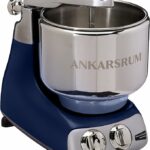
The Ankarsrum Assistant stand mixer costs around $800. According to the company, its mixer features a 7-liter bowl and can easily mix 5 kg (11 lbs) of dough using the dough hook. The Ankarsrum is a favorite among many micro-cottage bakers, even though the flexing position of the roller/hook requires attention during the mixing and kneading process. In this design, the bowl rotates and moves the dough, while the hook remains relatively stationary.
The maker of the Ankarsrum stand mixer claims that it is easy to use and clean due to its user-friendly design. I dig that. It features an intuitive control panel, a range of speeds, and a removable bowl, allowing for the development of firm dough. Additionally, it is equipped with a range of accessories for various uses. And the warranty is excellent.
I have seen YouTube videos showing dough creeping up the roller or hook on the Ankarsrum, but there is no crevice for the dough to seep into, unlike with the Bosch Universal Plus and its white bowl assembly. But a user pays for that benefit, as the Ankarsrum is more expensive.
https://www.ankarsrum.com/us/prepare-5-kilos-of-dough/
The Ankarsrum must be a decent stand mixer, as it has a great reputation.
Concerns
My most significant concern for now is not so much the volume of a bowl, the dough creep factor, or the motor torque of any of these mixers, but rather how much the kneading process raises the dough’s temperature. This, perhaps, is a moot point for most home bakers preparing dough for cookies or for a couple of loaves. But for an aspiring bread maker like me, it is a factor I think about.
A Word About Manufacturers’ And Distributors’ Claims To Superiority
I found the following video very enlightening. America’s Test Kitchen reminds folks to take the stated capacities of mixers with a grain of salt. I wonder why they didn’t include the Bosch Universal in their review.
It is essential to verify the warranty offered by manufacturers.
A Step Up
A step up from a home baker’s Bosch and Ankarsrum are spiral mixers, costing between $1,000 and $2,000 and up. These machines are not general-purpose mixers with various attachments, but more or less one-trick ponies. They are simply dough mixers and come with only a dough hook. These mixers operate with considerable power, producing smooth dough. It is said that spiral mixers do not raise the dough’s temperature as much as multi-purpose mixers.
Again, here is the secret to developing dough for exceptional bread: spiral mixers are recognized as the best tools for developing dough. Pizza shops love them. And so do bread bakeries.
https://www.bakemag.com/articles/5287-6-keys-to-buying-the-right-spiral-mixer
“Planetary mixers need gears to emulate the rotating bowl action of a spiral mixer, whereas spiral mixers use two motors — one to rotate the bowl and one to rotate the spiral arm — and a pulley system instead of gears. This results in smoother, quieter action.
While planetary mixers can offer great versatility for a wide range of jobs, spiral mixers offer capacity versatility by allowing users to mix less than 10 percent of the unit’s capacity, which is not possible with planetary mixers since batches that are too small will not incorporate sufficiently.
Spiral mixers are also better suited for kitchens that are focused on making dough. Planetary mixers have a rougher kneading action that results in the dough rising in temperature more quickly. Conversely, spiral mixers keep the dough at a lower temperature because the mixer bowl rotates as the spiral hook spins to knead the dough.
This gentler action and resulting lower dough temperature ensures that the dough doesn’t start the fermenting process too quickly or get overheated — resulting in proper activation of the yeast. Artisanal and specialty breads typically must ferment slowly, so temperature control is crucial in the process.”
Vevor

The 89 lbs VEVOR commercial food mixer is a 450W dual-rotating dough kneading machine featuring a food-grade stainless steel bowl, offering an 8.5-quart capacity. This allows for mixing up to 3 kg (6.6 lbs) of dough at a time.
At about $600, there is no tilting head or removable bowl, though. The dough mixer features a dual-rotation design, significantly enhancing the elasticity and toughness of dough. With a 21 r/min bowl and a 159 r/min hook, this machine can simulate the manual kneading process and mix the dough more evenly. However, it only runs on this one speed.
Ooni Halo Pro
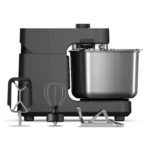
The Ooni Halo Pro, as of April 2025, is a new entry into the spiral mixer market. At 33 lbs and with a 7-liter bowl for up to 11 lbs or 5 kg of dough, this $800 mixer compares favorably to the Ankarsrum, at least when it comes to working with pizza dough. Ooni is renowned for its home pizza ovens, and this spiral mixer should work well for home pizza or bread production. The head tilts up, and the bowl is removable. Attachments such as a spiral dough hook, a geared whisk, and a flexible beater unlock a world of versatility for home bakers.
Like traditional spiral mixers, it features a rotating dough hook, a stationary breaker bar, and a spinning bowl. This creates a gentle, efficient kneading motion that mimics hand-kneading, preventing dough from overheating and promoting better gluten development.
KYS Pro Baker, Revo Baker

The 64 lbs KYS Pro Baker 7 and Revo Baker 7.5 are relatively new entries into the spiral mixer market. With a bowl volume of 7.5 liters, a maximum flour capacity of 3 kg, and 4.8 kg of dough at 60% hydration, these mixers are ideal for dough challenges. The adjustable speed makes it perfect for all types of dough, regardless of their hydration levels. This is especially useful when working with soft doughs and adding fat during the kneading process.
The Revo Baker appears to be little different in design from the KYS.
SpiralMac
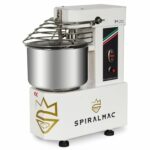
The 84 lbs SpiralMac SV8 Royal Queen mixes and kneads up to 17.6 lbs (8 kg) of dough at 60% hydration (or more at higher hydration), while also handling batches as small as 2.2 lbs (1.0 kg) at 60% hydration equally well. In terms of flour capacity, this ranges from 7 lbs (3.2 kg) to as little as 1 lb (0.48 kg). The stainless steel bowl has a capacity of 10.5 quarts (10 liters).
The Spiralmac mixer features a removable bowl, eliminating the complexity associated with operating a tilting head. Both the breaker bar and the dough hook are removable.
This is the mixer I am dreaming about.
Famag

The 77 lbs Famag IM-8 mixes and kneads up to 17.6 lbs. (8 kg) of dough at 60% hydration (or more at higher hydration), but also handles batches as small as 2.2 lbs. (1 kg) equally. The IM-8 mixer is available in two dough hook RPM ranges: 98-345 or 130-312 RPM.
In terms of flour capacity, this machine ranges from 7 lbs. (3.2 kg) to as little as 0.88 lbs. (0.4 kg) of flour. The stainless steel bowl has a capacity of 11.6 quarts (11 liters). The kneading arm of the Famag lifts high for bowl access and removal, providing lift assistance.
I am not sure that the Famag, popular as it seems, is the best deal around. Some reviewers noticed minor flaws (see below).
Alpha
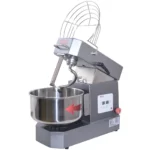
Another favorite, the 90 lbs Alpha AVS-10T costs around $1,000, but is relatively untested. The bowl capacity is approximately 10 liters (2.6 gallons) or 10.5 quarts, and the maximum mixing capacity is 5.6 kg (approximately 12.3 lbs) for dough. This capacity is generous for a low-cost mixer, and it is a real spiral mixer.
The unique variable-frequency motor offers numerous benefits, including quieter operation, increased mixing speeds, enhanced torque, and simplified maintenance. The digital controller interface makes operation easy and includes features such as inching, reverse, and a removable bowl to help with the dough removal and cleaning processes.
This mixer may be great for doughs with low and high hydration levels. The digital timer allows a baker to set the mixer and walk away while working on other tasks.
Sunmix 6

The 66 lbs SUN6 Basic costs around $2,000 and features a single-phase motor with an inverter, allowing for speed adjustment between 50 and 300 rpm, which offers maximum flexibility for different dough types.
This spiral mixer features a double mechanical action; the rotating bowl draws the dough toward the spiral, which simultaneously pushes it toward the divider bar. This process forms a very dense gluten mesh, which incorporates a lot of air inside.
The mixer has a 8.5-quart bowl for a dough capacity of 6 kg (13 lbs).
Sunmix mixers, residential and commercial, seem to be some of the best mixers a baker can buy.
AC Induction or DC Brushed Motor?
For the nerds (like me) among the readers, I had AI generate responses about various motor types that can be found in electronics, such as dough mixers.
The article above also compares a brushless DC motor, apparently the best of both worlds, to an AC induction motor and a DC brushed motor. Brushless motors do not have physical brushes that wear out, which is a key difference from brushed DC motors. Where torque at low RPM is essential, a DC brushed motor might be the simpler and more responsive choice. However, when scaling up to prosumer demands on mixers, manufacturers may opt for an AC induction motor with a variable frequency drive (VFD), also known as an inverter motor, that is tuned to deliver strong torque across a wide range.
This informative table of mixer specs is my work in progress, unconfirmed by manufacturers, and is in no particular order. Some manufacturers of spiral mixers offer models of various sizes for different markets, with some featuring a fixed bowl and breaker bar, while others have a tilting head. Their advised dough capacity is usually for dough at around 60% hydration.
| Mixer | Motor | Transmission | Bowl/Mixer Capacity |
| Artiste® (multi-function) | 500W universal brushed AC motor | variable-speed, belt-driven | 6.5 qt for up to 8 lb or 2.7 kg of dough |
| Bosch Universal® (multi-function) | 500W universal brushed AC motor | variable-speed, belt-driven | 6.5 qt for up to 14 lbs or 6 kg of dough |
| Ankarsrum® Assistant (multi-function) | 600W universal brushed AC motor | worm gear drive for variable-speed | 7.4 qt for up to 11 lbs or 5 kg of dough |
| KitchenAid® Commercial Series 8 (multi-function) | brushless DC (BLDC) motor | variable-speed | 8 qt for up to ? |
| Vevor® (spiral mixer) | 450W ? | single-speed | 8.5 qt for up to 6.6 lbs or 3 kg of dough |
| Ooni Halo Pro (multi-function) | 650W brushed DC motor | variable speed | 7.3 qt for up to 11 lbs or 5 kg of dough |
| KYS® Pro Baker 7 (spiral mixer) | 500W brushless AC inverter motor | variable-speed | 7.4 qt for up to 8.8 lbs or 4 kg of dough |
| Revo® Bake Titan (spiral mixer) | 750W brushless AC induction motor | inverter for variable-speed | 7.9 qt for up to 10.6 lbs or 4.8 kg of dough |
| Alpha® (spiral mixer) | 750W brushless AC induction motor | inverter for variable-speed, belt-driven | 10.5 qt for up to 12.3 lbs or 5.6 kg of dough |
| Famag® IM-8 (spiral mixer) | 400W brushless AC induction motor | inverter for variable-speed, chain overhead drive with dual belt transmission | 11.6 qt for up to 17.6 lbs or 8 kg of dough |
| SpiralMac® SV8 (spiral mixer) | 750W ? | inverter for variable-speed, oil-bath gear | 10.5 qt for up to 17.6 lbs. or 8 kg of dough |
| Sunmix® Easy 6 (spiral mixer) | 350W brushless AC induction motor | inverter for variable-speed | 8.5 qt for up to 13 lbs or 6 kg of dough |
Some Feedback on the Famag
James Bridges (Cottage Geeks group admin on Facebook, Feb. 5, 2024) quoted on the Famag mixers
“I have owned both Famag and Sunmix, and we have a Famag with a removable bowl at the bakery for R&D.
The tolerances are tighter on the Sunmix, with Famag having too much space between the breaker bar and the bottom of the bowl. There are also well-documented issues with the base of the bowl on the Famag, as well as the bowl sensors, which can fail so the mixer ceases to operate.
The Famag also has an exposed screw on the bowl spacer that makes cleaning the top challenging and is just an example of poor workmanship. There are also documented issues with the breaker bar bending under the stress of mixing due to how it is attached.
And finally, the Sunmix has better overall kneading action, so it performs better. I’m glad that Famag has an extended warranty, though; if yours fails, you might have a chance at getting it sorted.
They won’t say it publicly, but PHG isn’t pushing the Famag anymore and has pivoted toward the SpiralMac as their preferred mixer to sell. I’m a previous owner of Famag IM-40, and besides the IM-8S we already have at the bakery, I won’t ever own one again.
A perfect piece of bakery equipment does not exist, but after extensive use, I can confidently say Sunmix is the best spiral mixer available for home use. I recommend the Pro, but the basic is still a great mixer if one is on a budget. The Pro is better at handling wet dough, and the light and reverse are excellent.”
Understanding Mixer Terms: Planetary, Spiral, Fixed Bowl, Removable Bowl
The following article is adapted from DoughTech and discusses mixer types.
https://www.doughtech.com/understanding-mixer-terms-planetary-spiral-fixed-bowl-removable-bowl/
Planetary Mixer
Planetary mixers are given this name because of how the mixers revolve around the center of the bowl, like a planet around the sun. The bowl stays in place as the mixers cycle rapidly around. These are usually single-motor, non-rotating bowl mixers designed for general purpose, with various attachments that can be used to shred, chop, or grate other ingredients like cheese, meat, and vegetables.
However, as solely a bread mixer, they require additional attachments and are far more challenging to produce consistent and well-blended dough. A planetary mixer may be right for you if your business intends to produce more than just bread and has the necessary attachments and expertise. However, if your goal is solely to produce pizza dough, artisan bread, or baked goods, a spiral mixer is the tool for you!
Pros:
- Versatile
Cons
- Less airy dough
- Rougher & warmer mix
- Slower dough development
Spiral Mixer
Unlike a planetary mixer, a spiral mixer has a rotating bowl that spins while the spiral hook spins and kneads the dough, similar to hand kneading. This produces less friction and less heat on the dough, ensuring proper temperature for fermentation and speeding up dough development by 20%-30%. They can easily produce a much more consistent and well-blended mix than a planetary mixer, which is especially important in high-hydration artisan recipes. Spiral mixers form a very dense gluten mesh, incorporating a lot of air inside.
A 30-quart spiral mixer can handle 18 kg of dough, that is make twenty 900 lbs loaves.
Pros:
- Gentler on the dough
- Less heat and friction
- More uniform dough
- Faster Development (20-30% reduction in mix time)
Cons:
- Specifically for Dough
- No attachments are available.
Fixed Bowl Mixer
The term “Fixed Bowl” can be misleading since the bowl can rotate but not be removed. These are generally spiral mixers designed to be used in smaller bakeries and provide good baking speed for the price. They must be loaded and unloaded by hand every time, often requiring the baker to cut the flour into smaller-sized pieces for lifting.
Pros:
- Cheaper
- Compact
- Good for smaller operations
Cons:
- Have to cut out the dough
- Can’t remove the bowl for washing
- Slower workflow than with a removable bowl.
Removable Bowl Mixer
These mixers allow bowls to be removed and benefit significantly from this feature. Using multiple bowls can increase mixing capacity by 50-100%. By swapping a pre-loaded bowl every time, the time spent loading and unloading the bowl is simultaneous with the mixing process.
This reduces space on the floor compared to using multiple mixers and allows for further automation. Automated bowl lifters and tippers reduce heavy lifting from staff, lowering the risk of injury and labor costs and allowing them to focus on more skillful technical labor.
Pros:
- Significantly Faster Workflow
- Allows for Automation
- Easier to clean
Cons:
- More expensive
- More bowls take up space.